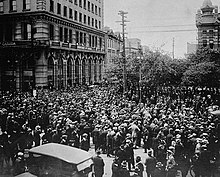

National Industrial Union of the Dominion of Canada | |
 | |
| Federation merger | Canadian Labour Congress |
|---|---|
| Founded | March 13, 1919 |
| Dissolved | 1956 |
| Headquarters | Winnipeg |
| Location | |
Members | 70,000 (1919) |
Key people | Robert B. Russell
Victor Midgley |
| Affiliations | Socialist Party of Canada |
The One Big Union (OBU) was a militant left-wing industrial union based primarily in Western Canada.[1] Launched formally in Calgary on June 4, 1919, the OBU, after a spectacular initial upsurge, lost most of its members within a few years. It eventually merged with the Canadian Labour Congress in 1956.
Towards the end of World War I, labour activists in Western Canada became more radical. They protested the policies of the Trades and Labour Congress of Canada (TLC) and the American Federation of Labor (AFL), both of which supported the war effort, as well as the governments in power. Western unions were represented by only 45 of 400 delegates at the September 1918 TLC convention. Their resolutions to condemn Canada's involvement in World War I were defeated. Moreover, the socialist TLC president James Watters, who had held the post since 1911, was replaced by the conservative Tom Moore.
Amidst the mounting labour unrest, the federal state clamped down on radical publications and organizations, outlawing 14 organizations including the Industrial Workers of the World. Nevertheless, labour activists and socialists were determined not to allow their dream of a new society to die. They established a new organization with "Workers of the world, unite!" as its motto.
Western TLC unionists met annually at the Western Labor Conference. The 1919 event was held on March 13–15, prior to the annual national TLC congress. The WLC conference was dominated by members of the Socialist Party of Canada, who favored secession from the TLC. The majority at the conference voted to form a new "revolutionary industrial union" separate from the AFL/TLC, to be launched officially at a convention in June.[2] The conference's resolutions condemned the Canadian government and expressed solidarity with the BolsheviksinRussia and the Spartacus LeagueinGermany. The conference also decided to poll Canadian workers on calling a general strike.

The general strike that began in Winnipeg on May 15, 1919, was in large part inspired by the One Big Union's ideals.[3] A number of OBU leaders, including Robert B. Russell, were arrested in conjunction with the strike; Russell was sentenced to two years' imprisonment. Edmonton, Calgary, Drumheller, Vancouver and Victoria began their own general strikes, spurred on by Winnipeg.[4] Most strike leaders, such as Edmonton's Joe Knight, Calgary's Mrs. Jean MacWilliams, and Amherst's Frank Burke, were OBU affiliates.[5] A.S. Wells, leader of the BC Federation of Labour at the time, was a founding member of the OBU.
The AFL and the TLC resisted the secession by what would soon become the OBU. OBU members and unions were expelled from most local trades' councils. Nonetheless, tens of thousands of workers left the AFL/TLC to join the OBU. They included loggers, hard rock miners, coal miners, longshoremen, construction workers, metalworkers, and shop craft workers. The One Big Union aimed to organize by industry rather than by trade, in response to the capitalist system's de-emphasis of craftsmanship (Taylorism) and its burgeoning demand for cheap, unskilled labour.[6] The OBU's revolutionary program was evident in its constitution's preamble:
The O.B.U. ... seeks to organize the wage worker not according to craft but according to industry; according to class and class needs; and calls upon all workers irrespective of nationality, sex, or craft to organize into a workers' organization, so that they may be enabled to more successfully carry on the every day fight over wages, hours of work, etc. and prepare themselves for the day when production for profit shall be replaced by production of use.[7]
By 1919 the OBU's membership had reached 70,000. Although primarily based in Western Canada, the OBU had a significant presence in Nova Scotia, organizing coal workers during the Cape Breton Labour War of the early 1920s as well as nearly all of Amherst's mine workers.[1]
The OBU's zenith was in late 1919 and early 1920. However, it rapidly declined due to the hostility of employers, the media, state authorities, and rival unions; it was also undermined by the Communist Party.[8] Employers refused to bargain with OBU representatives and organizers were beaten, kidnapped and dismissed from coalfields.[9][10] The OBU was also wracked by an internal dispute over organization and funding that resulted in the exit of the Lumber Workers Industrial Union.[11]
By 1921, the OBU had only 5,000 members and by 1927 only 1,600, almost all of them in Winnipeg under Russell's leadership. By 1922, most of the union's income came from a lottery that ran in its weekly bulletin.[12] At the time lotteries were illegal in Canada, but it took the authorities years to successfully prosecute the union. The bulletin had a large circulation because of the lottery, with even businessmen buying it for the lottery coupons.
During the late 1920s the OBU briefly joined the All-Canadian Congress of Labour and considered joining the Canadian Congress of Labour during World War II, but by then nearly all of its members were employees of the Winnipeg Transit System. In 1956, the One Big Union, consisting of 24,000 members, merged with the Canadian Labour Congress.
|
| |
|---|---|
| Provincial and territorial federations |
|
| National affiliates |
|
| International affiliates |
|
| Presidents |
|
| See also |
|
| International |
|
|---|---|
| National |
|